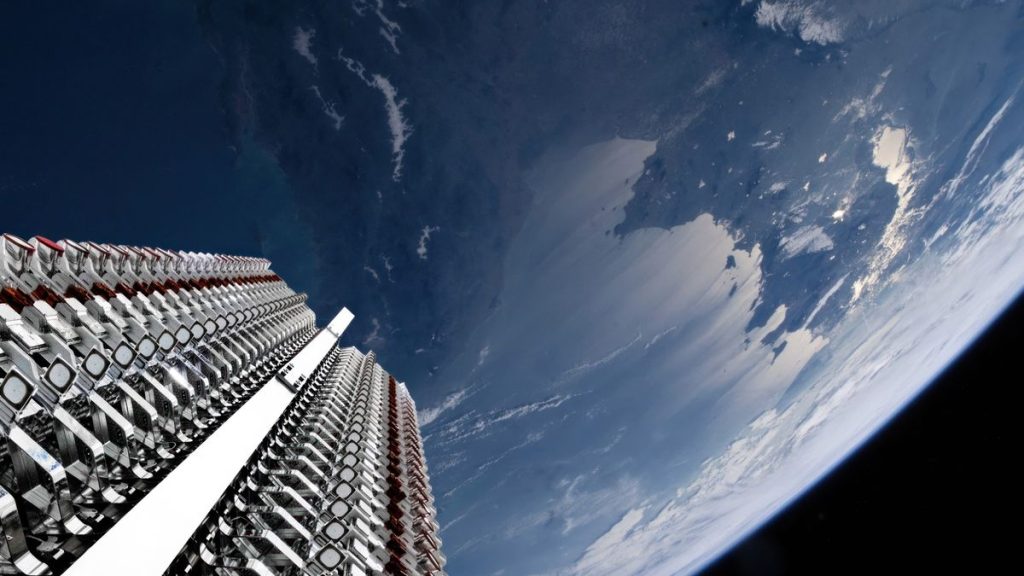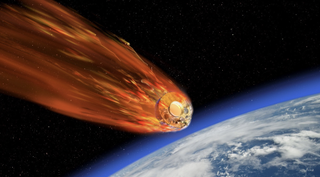
How much do SpaceX’s reentering Starlink satellites pollute Earth’s atmosphere? (Image Credit: Space.com)
Satellite megaconstellation operators are getting a lot of flak from atmospheric scientists lately for polluting Earth’s upper atmosphere. But is the criticism justified? Who is the biggest contributor to the emerging environmental problem?
About 40% of disused satellites burning up in Earth’s atmosphere these days belong to SpaceX‘s Starlink megaconstellation, according to Andrew Bacon, the chief technology officer and co-founder of U.K.-based in-orbit manufacturing firm Space Forge.
That amounts to “a minimum of 500 kilograms [1,100 pounds]” of incinerated satellite trash a day, added Bacon, who presented those numbers at the workshop on Protecting Earth and Outer Space from the Disposal of Spacecraft and Debris held at the University of Southampton in the U.K. on Sept. 23 and Sept. 24.
These satellites are mostly made of aluminum, which turns into aluminum oxide when burned at high temperatures, such as those experienced by satellites hurtling through Earth’s atmosphere at orbital speeds. This aluminum ash accumulating at high altitudes worries scientists because of its potential to damage Earth’s protective ozone layer and alter its albedo — the ability to reflect sunlight — which could result in changes in the temperature of the upper atmosphere.
Related: Pollution from rocket launches and burning satellites could cause the next environmental emergency
Jonathan McDowell, an astronomer at Harvard and Smithsonian and a leading space debris expert, agreed that Starlink satellites “are dominating” among the clutter incinerated in Earth’s atmosphere.
“There is now a Starlink reentry almost every day,” McDowell told Space.com. “Sometimes multiple.”
SpaceX began launching its Starlink constellation in 2019 and now flies about 6,500 of the spacecraft. Ultimately, Elon Musk‘s company wants to grow the fleet to more than 40,000 satellites.
More satellites also mean more rocket launches. In this domain, SpaceX also reigns supreme. Out of the 211 successful orbital launches conducted worldwide in 2023, 98 were done by SpaceX. In 2024, SpaceX has already matched that record, having completed 98 orbital launches as of mid- October (as well as three test flights of its Starship megarocket).
Although SpaceX’s Falcon 9 and Falcon Heavy first stages famously return to Earth to be reused, the 4-ton upper stages join the swarms of space debris and eventually fall back to Earth, burning up in the atmosphere ing the process. As the upper stages are also made mostly of aluminum, their demise likely produces the harmful aluminum oxide, too.
McDowell said that, over the past five years, the number of reentering rocket stages has increased from between 50 and 100 per year to around 300 per year.
“We are seeing a similar increase in the number of satellites now that hundreds of Starlink satellites are starting to come down,” McDowell said.
SpaceX designs Starlink satellites to be replaced about every five years with newer, more capable models. When the old spacecraft reach the end of their life, operators guide them to reentry. The megaconstellation will thus keep generating a steady stream of debris vaporizing in the atmosphere. But does it make SpaceX the worst polluter of the upper atmosphere? The answer is not so simple.
Connor Barker, a researcher in atmospheric modeling at University College London, told Space.com that, currently, satellite megaconstellation launches and reentries are responsible for only about 12% of the overall ozone depletion caused by the global space sector. Starlink, being by far the largest megaconstellation, must be responsible for the majority of those 12%.
To launch its satellites, SpaceX relies on the Falcon 9 rocket, which burns a type of fuel similar to the aviation propellant kerosene and emits soot. Although soot in the atmosphere could contribute to climate change and further ozone depletion, it is nowhere near as harmful as byproducts of solid rocket motors, said Barker. Those are used, for example, in China’s Long March 11, India’s Polar Satellite Launch Vehicle and in strap-on boosters of United Launch Alliance’s Atlas V or Europe’s new Ariane 6.
“The reason [solid rocket motors] are so bad is because they emit alumina particles and chlorine, which no other propellant does,” said Barker. “Those boosters are sometimes still consuming propellant in the stratosphere, so they’re emitting chlorine and alumina right where the ozone is, and that’s really depleting it very quickly. Solid rocket fuel is the worst for ozone depletion.”
Barker, however, thinks that the 12% contribution of megaconstellation launches and reentries to the space industry’s impact on the ozone layer is not entirely good news.
Megaconstellations, he said, have barely begun to be deployed. The total number of orbiting satellites is expected to balloon into the tens of thousands — and perhaps even 100,000 — over the next decade.
“As we move into the main megaconstellation era, we will start to see many more rocket launches and many more reentries,” said Barker. “And then, the number will grow.”
Related: Burned-up space junk pollutes Earth’s upper atmosphere, NASA planes find
Currently, the space industry contributes only about 0.1% to the overall damage to the ozone layer caused by humankind. That seems negligible, but researchers caution that, because satellites burn up at altitudes between 37 miles and 50 miles (60 to 80 kilometers), the air pollution their incineration produces will remain in the air for decades, maybe centuries. The same goes for the soot and gases from rocket exhaust.
“We are applying a new input into the atmosphere that hasn’t been there before,” said McDowell. “We’re in an uncharted territory.”
Barker and McDowell are co-authors of a paper assessing emissions from megaconstellation launches and reentries that was published Oct. 3 in the journal Scientific Data.






